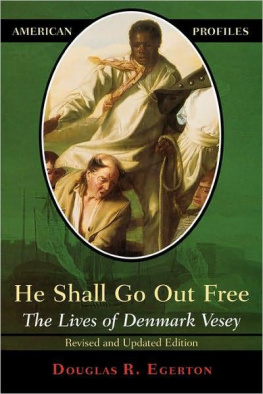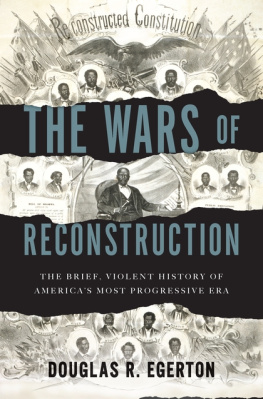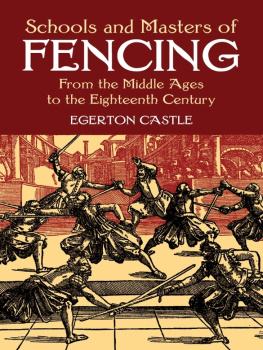1993 The University of North Carolina Press
All rights reserved
Manufactured in the United States of America
The paper in this book meets the guidelines for permanence and durability of the Committee on Production Guidelines for Book Longevity of the Council on Library Resources.
Library of Congress Cataloging-in-Publication Data
Egerton, Douglas R.
Gabriels rebellion: the Virginia slave conspiracies of 1800
and 1802/Douglas R. Egerton.
p. cm.
Includes bibliographical references and index.
ISBN 0-8078-2113-6 (alk. paper).
ISBN 0-8078-4422-5 (pbk. : alk. paper)
1. SlaveryVirginiaInsurrections, etc. 2. VirginiaHistory17751865. 3. Prosser, Gabriel, ca. 17751800.
I. Title.
F230.E37 1993
975.503dc20 9318534
CIP
03 02 01 00 99 8 7 6 5 4
Preface
The spring of 1800 found Richmond, Virginia, a feverish tribute to partisan politics; the April elections for the General Assembly were crucial for both Federalists and Republicans in the upcoming presidential contest. The accompanying unrest, discord, and rumors of impending disunion inspired a young slave named Gabriel to conceive of what was perhaps the most extensive slave conspiracy in southern history. Most of his contemporaries, white as well as black, believed that his plan stood a good chance of succeeding. Had it done so, it might have changed not only the course of American race relations but also the course of American political history.
It is peculiar, therefore, that Gabriels conspiracy has been either ignored or misunderstood by historians. Despite a wealth of documentation, the plot and its tragic aftermath have never been treated in full. True, Gabriel typically receives a perfunctory mention in most American history textbooks, although many identify him as Gabriel Prosser, thus giving him the surname of his owner, Thomas Henry Prosser (which no extant contemporary document does). Far too many scholars identify him as a free man, although his tenuous ties to his master make this error somewhat understandable. One writer has even insisted that Gabriel must have been Haitian, although the Virginia census of 1783 clearly places the then-seven-year-old boy on the Prosser plantation nearly a decade before Saint Domingue exploded into revolution. But of all the myths surrounding the events of 1800, surely the most durable is the erroneous idea that Gabriel was a messianic figure, an early national Nat Turner who wore his hair long in imitation of his biblical hero, Samson.
Several fictional treatments have attempted to rescue the slave rebel from the Samson legend, but in the process they have led readers and audiences into yet new myths. Arna Bontempss vivid 1936 novel, Black Thunder, depicted Gabriel as a meek, apolitical bondman driven to revolt only by his masters cruel murder of an elderly slave. Thirty-two years later, Clifford Masons powerful play Gabriel: The Story of a Slave Rebellion, placed the Virginia revolutionary in a generic plantation setting. By day, Masons Gabriel was a common laborer in Charlie Prossers cotton fields. By night, Masons heroin a development oddly reminiscent of the fiction that justifiably offended critics of William Styrons Nat Turnerwas a sexual athlete who attended to the needs of the love-starved plantation mistress.
The historical Gabriel who emerges from the voluminous trial records was none of these things. The young husband was no rustic farmhand but a highly skilled blacksmith who hired out his time around the Richmond area. Far from being meek or timid, this born rebel had so little prejudice against violence that he once bit off the left ear of a white neighbor during an angry dispute over a stolen hog. Most of all, the Gabriel who engineered a complex conspiracy with branches in at least three Virginia cities was no apolitical servant but a literate artisan whose breadth of vision was truly international. Far from praying for the religious day of jubilee, the black Jacobin labored to gather together the most redoubtable democrats in the state to destroy the economic hegemony of the merchants, the only whites he ever identified as his enemies.
This book unapologetically tells a story. This currently unfashionable approach need not, of course, eschew analysis. But Gabriels short lifeand the chain of events he precipitatedwere dramatic, and it would be a nearly criminal act if the story did not unfold for the reader as it did for those who lived through it. In hopes of giving equal attention to both story and interpretation, the book is presented in two sections. Part 1 seeks to re-create the context of the conspiracy. The first chapters explore the political and economic landscape of Virginia during the two decades following the Revolution. The disorder of war and the climate of insubordination produced by the rebellious patriots, as well as the gentrys growing recognition of the hypocrisy in yelping for liberty while denying it to others, served to break down the old controls that held slavery in place, even as it emboldened bondmen to free themselves by tramping north or by picking up a musket in the name of King George.
The pervasive language of liberty and equality, which reached its rhetorical peak during the overheated partisan warfare of the late 1790s, could not help but politicize black Virginians. This was particularly true of urban slaves and freemen who labored alongside stalwart white artisans, many of whom were members of the Democratic-Republican societies of Richmond and Norfolk. Most urban bondmen lacked a sophisticated understanding of the political issues they overheard, but that is hardly the point; popular revolutions often arise from conjunctions between the aspirations of the disenfranchised majority and the demands of the politically conscious minority. Only when Gabriels plan is placed against the turbulent political background of 1800 does the logic of his conspiracy emerge. By taking advantage of what he believed to be an impending civil war between Republicans and Federalists, Gabriel hoped his urban followers could force the Federalist merchants to yield to his simple demands for justice. It was not merely that the conspiracy developed during a time of division among whites; it was that artisan Gabriel, sharing the same small-producer ideology of many urban Republicans, hoped to join in and exploit that division. His faith was that white mechanics would see in his own struggle for liberty and economic rights grounds for accepting his support and that of his soldiers. The remaining chapters of Part 1 chronicle the collapse of the plan and the execution of most of Gabriels followers.
Part 2 carries the story beyond Gabriels death; history, unlike literature, invariably fails to tie together all of its loose ends. The narrative moves through a second plot, an even more widespreadif less coherent and politically consciousattempt to bring down the peculiar institution. Organized in late 1801 and early 1802 by Sancho, a minor recruiter who stood on the periphery of the earlier conspiracy, the Easter Plot, as it came to be known, finally grew so unwieldy that it snapped into three semiautonomous schemes, thus diminishing its chances for success.
The final chapters examine the unhappy legacy of the two near revolts. Between 1801 and 1805, the Virginia Assembly, terrified by the recurrent specter of true revolution, quietly debated the possibility of gradual emancipationalbeit with the qualifying tie of colonization. Following the failure of President Thomas Jefferson to implement its recommendations, the state legislature decided against any further plan of reform and chose instead to restore the old colonial instruments of control in order to better discipline a troublesome labor force and crush its rebellious spirit.








